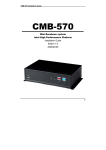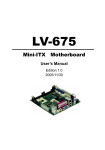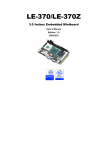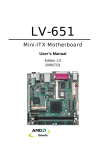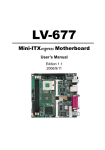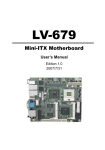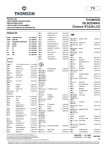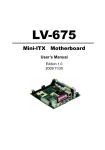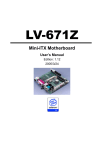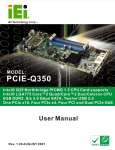Download AMD LE-363 User's Manual
Transcript
LE-363 3.5 inch Embedded Motherboard User’s Manual Edition 1.0 2005/9/16 LE-363 User’s Manual Copyright Copyright 2004 - 2005. All rights reserved. This document is copyrighted and all rights are reserved. The information in this document is subject to change without prior notice to make improvements to the products. This document contains proprietary information and protected by copyright. No part of this document may be reproduced, copied, or translated in any form or any means without prior written permission of the manufacturer. All trademarks and/or registered trademarks contains in this document are property of their respective owners. Disclaimer The company shall not be liable for any incidental or consequential damages resulting from the performance or use of this product. The company does not issue a warranty of any kind, express or implied, including without limitation implied warranties of merchantability or fitness for a particular purpose. The company has the right to revise the manual or include changes in the specifications of the product described within it at any time without notice and without obligation to notify any person of such revision or changes. Trademark All trademarks are the property of their respective holders. 2 LE-363 User’s Manual Packing List Please check the package before you starting setup the system Hardware: LE-363 little board x 1 Cable Kit: 44-pin 40-pin 44-pin 44-pin ATA33 IDE Cable x 1 COM port & Printer Port Cable x 1 USB Cable x 1 PS/2 keyboard & mouse cable x 1 Audio Cable x 1 Floppy Cable x 1 1 to 3 power output cable Other Accessories: Divers CD (including User’s Manual) x 1 Printed User’s Manual x 1 3 LE-363 User’s Manual Index Chapter 1 <Introduction>...............................................................6 1.1 <Product Overview> ......................................................................6 1.2 <Product Specification> .................................................................7 1.3 <Mechanical Drawing>..................................................................9 1.4 <Block Diagram> .........................................................................10 Chapter 2 <Hardware Setup> ...................................................... 11 2.1 <Connector Location>..................................................................11 2.2 <Jumper Location & Reference> .................................................12 2.3 <Connector Reference>................................................................13 2.3.1 <Internal Connector> ........................................................13 2.3.2 <External Connector> .......................................................13 2.4 <CPU & Memory Setup>.............................................................14 2.4.1 <CPU>...............................................................................14 2.4.2 <Memory>.........................................................................14 2.5 <CMOS Setup> ............................................................................15 2.6 <Enhanced IDE & CF Interface>.................................................16 2.7 <Floppy Port>...............................................................................17 2.8 <Ethernet Interface>.....................................................................18 2.9 <Onboard Display Interface>.......................................................19 2.10 <Onboard Audio Interface> .......................................................26 2.11 <Serial Port>...............................................................................27 2.12 <GPIO Interface> .......................................................................28 2.13 <Power Supply> .........................................................................29 2.13.1 <Power Input>.................................................................29 2.13.2 <Power Output> ..............................................................29 2.14 <Switch and Indicator> ..............................................................30 Chapter 3 <BIOS Setup>..............................................................31 Appendix A <I/O Pin Assignment>..............................................33 A.1 <IDE Port> ..................................................................................33 4 LE-363 User’s Manual A.2 <Floppy Port>..............................................................................34 A.3 <IrDA Port>.................................................................................34 A.4 < VGA Port >...............................................................................34 A.5 <Serial Port>................................................................................35 A.6 <LAN Port>.................................................................................35 A.7 <PS/2 Keyboard & Mouse Port>.................................................35 A.8 < USB Interface >........................................................................35 A.9 < LPT Prot >……………………………………………..36 Appendix B <Flash BIOS> ...........................................................37 B.1 BIOS Auto Flash Tool ............................................................37 B.2 Flash Method ..........................................................................37 Appendix C <System Resources> ..............................................39 C.1 <I/O Port Address Map> .............................................................39 C.2 <Memory Address Map>.............................................................41 C.3 <System IRQ & DMA Resources> .............................................42 C.3.1 <IRQ> ...............................................................................42 Appendix D <Programming GPIO’s> ..........................................43 Appendix E <Programming Watchdog Timer > .........................44 5 LE-363 User’s Manual Introduction Chapter 1 <Introduction> 1.1 <Product Overview> LE-363 is the 3.5 inches embedded motherboard with AMD Geode GX533 platform, with onboard VGA, AC97 audio, dual LAN and DC 12V input interface. Based on the AMD Geode GX533 processor, the board provides many advanced features for reduced power consumption, fanless design and high cost/price rate of production. Low Power Consumption Based on the AMD Geode GX533@400MHz processor onboard, it only takes up to 8.4W at maximum powering, and is completely suitable for fanless design. Without any cooling fan onboard, it can avoid the heat problem when the cooler failed in accidence. Onboard TTL/LVDS LCD interface Based on the AMD Geode GX533@400Mhz of integrated graphics, the board provides onboard graphics with up to 4/8/12/16 MB of frame buffer, 18-bit/24-bit LVDS and 24-bit TTL interfaces. Embedded Component Due to the low profile design, the board provides PCMICA card Bus, CF card socket for flash disk with porting embedded OS and up to 512MB of DDR SO-DIMM. Single Voltage Input The board only requires DC 12V input; user’s can easily connect the board with an adapter without the huge power supply. 6 Product Overview LE-363 User’s Manual Introduction 1.2 <Product Specification> General Specification Form Factor CPU Memory Chipset USB Port BIOS Green Function Watchdog Timer Real Time Clock Enhanced IDE 3.5 inches embedded motherboard Embedded AMD Geode GX533 400MHz Fanless with heatsink only 1 x 200-pin DDRSO-DIMM up to 512MB Unbufferred, none-ECC memory supported only AMD Geode CS5535 Two internal USB1.1 ports Phoenix-Award PnP flash BIOS Power saving mode includes doze, standby and suspend modes. ACPI version 1.0 and APM version 1.2 compliant System reset programmable watchdog timer Chipset built-in RTC with lithium battery One Ultra DMA33 IDE interface supports up to 2 ATAPI devices One 44-pin IDE port onboard Multi-I/O Port Chipset Serial Port Parallel Port Floppy Port IrDA Port K/B & Mouse GPIO Hardware Monitor WINBOND W83627HF One external RS232 and one internal RS232 One 26-pin internal parallel port One slim type Floppy port One IrDA compliant Infrared interface supports SIR External PS/2 keyboard and mouse ports on rear I/O panel One 12-pin Digital I/O connector with 8-bit programmable I/O interface Fan speed, CPU temperature and voltage monitoring VGA Display Interface Chipset Memory Display Type Connector AMD Geode GX533 built-in VGA controller with 2D engine BIOS selectable up to 4/8/12/16 MB shard with system memory CRT, LCD monitor with analog display 18-bit/24-bit LVDS/24-bit TTL with LCD interface External DB15 female connector on rear I/O panel Onboard 40-pin TTL connector Onboard 40-pin LVDS connector Onboard 5-pin backlight inverter connector Solid State Disk Interface Compact Flash DOM PCMCIA Card Product Specification 1 x Compact Flash Card Type I socket on solder side Onboard 44-pin IDE support DOM (Disk On Module) PCMICA Type I/II slot 7 LE-363 User’s Manual Introduction Ethernet Interface Controller Type Connector Dual PCI based REALTEK 8100B controller 10Base-T / 100Base-TX, auto-switching Fast Ethernet Full duplex, IEEE802.3U compliant Two external RJ45 jack on I/O panel Audio Interface Controller Output Interface Connector REALTEK ALC201A AC97 codec Line-in, Line-out, CD-in, MIC-in Onboard 10-pin header Expansion Interface Mini PCI Onboard Mini PCI socket for Type III (32bit,33Mhz) Power and Environment Power requirement Input Voltage Input Current Dimension Temperature DC 12V input 1 x DC jack on I/O panel 1 x Onboard 4-pin 12V DC connector 10.5V ~ 13V 12V/0.7A 8.4W (board only) 146mm x 101mm (L x W) Operating within 0 ~ 60oC (32 ~ 140oF) Storage within -20 ~ 85oC (-4 ~ 185oF) Driver support Windows Linux Windows XP/XPe, Win2000 and WinCE Kernel version 2.4 or later Ordering Code LE-363P LE-363-128 8 3.5 inches embedded motherboard with onboard AMD GX533 400MHz processor, VGA, audio, dual LAN, USB, CF, TTL/LVDS PCMAIC ,Mini PCI , GPIO Same as LE-363P and with onboard DDR 128M Product Specification LE-363 User’s Manual Introduction 1.3 <Mechanical Drawing> Mechanical Drawing 9 LE-363 User’s Manual Introduction 1.4 <Block Diagram> AMD Geode GX533 Processor VGA monitor TTL/LVDS LCD DDR SO-DIMM up to 512MB PCI/33Mhz Ultra DMA33 IDE USB1.1 X 2 Arbitor IT8209 8100B AC97 Audio CS5535 Floppy 8100B Serial Port GPIO PCMCIA Parallel Port Mini PCI slot IrDA BIOS 10 Block Diagram LE-363 User’s Manual Hardware Setup Chapter 2 <Hardware Setup> 2.1 <Connector Location> CN_IR IDE Mini PCI CD IN CN_USB JFRNT CN_LVDS CN_AUDIO CN_COM2 CN_LPT CN_LCD JRTC CN_JVLCD CN_SPWR CN_12V CN_INV CN_DIO DC_IN JCRT/TFTSEL CF Connector Location SYSFAN PCMCIA 11 LE-363 User’s Manual Hardware Setup 2.2 <Jumper Location & Reference> Jumper JRTC JVLCD JCRT/TFTSEL Function RTC/CMOS Setting LCD Driving Voltage Setting Select CRT/TFT Setting JRTC JVLCD JCRT/TFTSEL 12 Jumper Location & Reference LE-363 User’s Manual Hardware Setup 2.3 <Connector Reference> 2.3.1 <Internal Connector> Connector DIMM IDE FDD CN_12V CN_AUDIO CDIN CN_DIO CN_USB SYSFAN CN_COM2 CN_IR CF PCMICA LPT CN_TTL CN_LVDS CN_INV CN_SPWR JFRNT Function Onboard 200-pin DDR SO-DIMM socket 44-pin primary IDE connector 26-pin slim type floppy connector 4-pin power supply connector 5 x 2-pin audio connector 4-pin CD-ROM audio input connector 6 x 2-pin digital I/O connector 5 x 2-pin USB connector 3-pin system cooler fan connector 5 x 2-pin RS232 serial port 5-pin IrDA connector Compact Flash Type I socket (Solder Side) PCMICA Card bus Type I/II slot(Solder Side) 26-pin parallel port connector 40-pin TTL LCD interface 20-pin LVDS LCD interface 5-pin LCD backlight inverter connector 4-pin 5V/12V power output connector 14-pin front panel switch/indicator connector Remark Standard Slim Slim Standard Standard Standard Standard Standard Standard Standard Standard Standard Standard Standard Standard Standard Standard Standard Standard 2.3.2 <External Connector> Connector VGA RJ45_1/2 COM1 PS2 DC_IN Function DB15 VGA connector RJ45 LAN connector Serial port connector PS/2 Keyboard/Mouse connector DC 12V input jack Connector Reference Remark Standard Standard Standard Standard Standard 13 LE-363 User’s Manual Hardware Setup 2.4 <CPU & Memory Setup> 2.4.1 <CPU> The board integrates AMD Geode GX533 400MHz processor with special design for power appliance. It requires only 8.4W power consumption at most, and is totally designed for fanless system. 2.4.2 <Memory> Based on AMD GX533 processor with built-in memory controller, the board provides one 200-pin DDR SO-DIMM socket support up to 512MB of capacity. To install the DDR SO-DIMM module, please insert the module into the socket at 45 degree, then press down the module with a click sound. (1. Insert the DDR SO-DIMM module into the socket at 45 degree) (2. Press down the module with a click sound) 14 CPU & Memory Setup LE-363 User’s Manual Hardware Setup 2.5 <CMOS Setup> The board’s data of CMOS can be setting in BIOS. If the board refuses to boot due to inappropriate CMOS settings, here is how to proceed to clear (reset) the CMOS to its default values. Jumper: JRTC Type: Onboard 3-pin jumper JRTC 1-2 2-3 Default setting Mode Clear CMOS Normal Operation JRTC 1 3 CMOS Setup 15 LE-363 User’s Manual Hardware Setup 2.6 <Enhanced IDE & CF Interface> The board supports one Ultra DMA33 IDE interface, dual channel for 2 ATAPI devices. The board also provides a Compact Flash Type I socket on secondary IDE channel and one onboard type I/II PCMICA Card Bus on the solder side. 43 1 44 2 IDE CF PCMCIA 16 Enhanced IDE & CF Interface LE-363 User’s Manual Hardware Setup 2.7 <Floppy Port> The board provides a slim type floppy port; please use the 26-pin ribbon cable in the package to connect the floppy device. FDD Floppy rear side 1. Floppy Port 4. Lift up this plastic bar 5. Slot the cable in (Blue paste for outside) 6. Press back the plastic bar Lift up the brown plastic bar 2. Slot the cable in (Blue paste for 3. brown bar side) Press back the plastic bar 17 LE-363 User’s Manual Hardware Setup 2.8 <Ethernet Interface> The board integrates two PCI based Ethernet controller with REALTEK 8100B, full compliance with IEEE 802.3u 100Base-T specifications and IEEE 802.3x Full Duplex Flow Control. RJ45_2 18 RJ45_1 Ethernet Interface LE-363 User’s Manual Hardware Setup 2.9 <Onboard Display Interface> The board integrates AMD Geode GX533 processor with built-in 2D video engine, to provide onboard DB15 VGA connector, 24-bit TTL and 18-bit/24-bit LVDS interface. The built-in 2D video engine supports following specified functions: ●High-performance 2D graphics controller ●Alpha BLT ●Integrated dot clock PLL 20 19 2 1 CN_LVDS 1 2 CN_LCD CRT 39 40 1 5 1 3 JVLCD 1 3 CN_INV JCRT/TFTSEL JCRT/TFTSEL 1-2 2-3 Mode TFT CRT Default setting Onboard Display Interface 19 LE-363 User’s Manual Hardware Setup In order to setup the LCD display well, please check the jumper setting before you use. Jumper: JVLCD Type: onboard 3-pin header JVOLT 1-2 2-3 Default setting Mode +5V +3.3V Connector: CN_INV Type: onboard 5-pin header Pin 1 2 3 4 5 Description +12V Ground Ground Ground ENBKL Jumper: JCRT/TFTSEL Type: onboard 3-pin header 20 JCRT/TFTSEL 1 2 Description VCC VGASEL 3 Ground Onboard Display Interface LE-363 User’s Manual Hardware Setup Connector: CN_LVDS ( for 24bit Signal channel LVDS panel ) Type: 40-pin header (40 x 2 pitch 2.0 mm) Connector model: Hirose DF13- 40DP-1.25V Pin 2 4 6 8 10 12 14 16 18 20 22 24 26 28 30 32 34 36 38 40 Signal (18-bit) LCDVCC GND NC NC GND NC NC GND NC NC GND NC NC GND NC NC GND N/C N/C N/C Pin 1 3 5 7 9 11 13 15 17 19 21 23 25 27 29 31 33 35 37 39 Signal (24-bit) LCDVCC GND BTX0BTX0+ GND BTX1BTX1+ GND BTX2BTX2+ GND BTX3BTX3+ GND BTXCKBTXCK+ GND N/C N/C N/C 24-bit Signal Onboard Display Interface 21 LE-363 User’s Manual Hardware Setup Connector: CN_LVDS ( for 18bit Signal channel LVDS panel ) Type: 40-pin header (40 x 2 pitch 2.0 mm) Connector model: Hirose DF13-40DP-1.25V Pin 2 4 6 8 10 12 14 16 18 20 22 24 26 28 30 32 34 36 38 40 Signal (18-bit) LCDVCC GND ATX0ATX0+ GND ATX1ATX1+ GND ATX2ATX2+ GND ATXCK0ATXCK1+ GND N/C N/C GND N/C N/C N/C Pin 1 3 5 7 9 11 13 15 17 19 21 23 25 27 29 31 33 35 37 39 Signal (24-bit) LCDVCC GND NC NC GND NC NC GND NC NC GND NC NC GND NC NC GND N/C N/C N/C 18-bit Signal 22 Onboard Display Interface LE-363 User’s Manual Hardware Setup Connector: CN_LCD Type: onboard 2 x 20-pin header with housing, pitch=2.0mm Pin 1 3 5 7 9 11 13 15 17 19 21 23 25 27 29 31 33 35 37 39 Signal ENAVDD GND LCDVCC GND FPD0 FPD2 FPD4 FPD6 FPD8 FPD10 FPD12 FPD14 FPD16 FPD18 FPD20 FPD22 N/C FPCLK RM GND Pin 2 4 6 8 10 12 14 16 18 20 22 24 26 28 30 32 34 36 38 40 Signal ENBKL GND LCDVCC GND FPD1 FPD3 FPD5 FPD7 FPD9 FPD11 FPD13 FPD15 FPD17 FPD19 FPD21 FPD23 N/C VSYNC HSYNC GND To setup the LCD, you need the component below: 1. A panel (support up to 18-bit/24-bit color) with TTL or LVDS interfaces. 2. An inverter for panel’s backlight power. 3. A LCD cable and an inverter cable. For the cables, please follow the pin assignment of the connector to make a cable, because every panel has its own pin assignment, so we do not provide a standard cable; please find a local cable manufacture to make cables. Onboard Display Interface 23 LE-363 User’s Manual Hardware Setup LCD Installation Guide: 1. Preparing the LE-363, LCD panel and the backlight inverter. 2. Please check the datasheet of the panel to see the voltage of the panel, and set the 3. If your panel is for TTL interface, you would need a TTL type cable. jumper JVLCD to +5V or +3.3V. Board side Panel side For sample illustrator only 4. IF your panel is for LVDS interface, you would need a LVDS type cable. Board side Panel side For sample illustrator only 5. 24 To connect all of the devices well. Onboard Display Interface LE-363 User’s Manual Hardware Setup After hardware setup well, you need to select the panel type in the BIOS. Panel Type Support List: 1 2 3 Onboard Display Interface Panel Number Resolution 640 x 480 800 x 600 1024x 768 25 LE-363 User’s Manual Hardware Setup 2.10 <Onboard Audio Interface> The board provides onboard AC97 audio interface with REALTEK ALC201A codec. Please use attached audio cable in the package to have Line-out, Line-in and MIC-in interfaces. Connector: CN_AUDIO Type: 10-pin (2 x 5) 1.27mm x 2.54mm-pitch header Pin Description Pin Description 1 Line – Right 2 Ground 3 Line – Left 4 MIC 5 MIC 6 Ground 7 N/C 8 Line Out – Left 9 Line Out – Right 10 Ground Connector: CDIN Type: 4-pin header 2.54mm pitch header Pin Description 1 CD – Left 2 Ground 3 Ground 4 CD – Right 9 1 CN_AUDIO 10 2 1 CDIN 4 Line-In MIC Line-Out 26 Onboard Audio Interface LE-363 User’s Manual Hardware Setup 2.11 <Serial Port> The board provides one RS232 COM port on real I/O panel with DB9 as COM1, onboard CN_COM2 RS232 serial port and one onboard parallel connector. 1 2 10 9 CN_COM2 1 14 COM1 CN_LPT 13 Serial Port 26 27 LE-363 User’s Manual Hardware Setup 2.12 <GPIO Interface> The board offers 8-bit digital I/O to customize its configuration to your control needs. For example, you may configure the digital I/O to control the opening and closing of the cash drawer or to sense the warning signal from a tripped UPS. The following is a detailed description of how the digital I/O is controlled via software programming. Connector: CN_DIO Type: 12-pin (6 x 2) 1.27mm x 2.54mm-pitch header Pin Description Pin 1 Ground 2 3 D0 4 5 D1 6 7 D2 8 9 D3 10 11 +5V 12 Description Ground D4 D5 D6 D7 +12V 1 2 CN_DIO 11 28 12 GPIO Interface LE-363 User’s Manual Hardware Setup 2.13 <Power Supply> 2.13.1 <Power Input> The board requires DC 12V input with onboard DC jack or 4-pin 12V DC connector. Connector: CN_12V Type: 4-pin standard ATX2.0 +12V power connector Pin Description Pin Description 1 Ground 2 Ground 3 +12V 4 +12V 2.13.2 <Power Output> The board also provides one 4-pin connector with +5V/+12V output. PS: Maximum output current for 5V/1A & 12V/1A Connector: CN_SPWR Type: 4-pin P-type connector for +5V/+12V output Pin Description Pin Description Pin Description 1 +12V 2 Ground 3 Ground Pin 4 Description +5V 4 CN_SPWR 1 3 2 4 1 CN_12V Power Supply 29 LE-363 User’s Manual Hardware Setup 2.14 <Switch and Indicator> The JFRNT provides front control panel of the board, such as power button, reset and beeper, etc. Please check well before you connecting the cables on the chassis. Connector: JFRNT Type: onboard 14-pin (2 x 7) 2.54-pitch header Function Signal PIN Signal HDLED 1 2 PWDLED Active 3 4 N/C Reset 5 6 GND GND 7 8 VCC N/C 9 10 N/C Power PWRBT 11 12 N/C Button 5VSB 13 14 SPKIN Function IDE LED Power LED Reset Speaker 13 14 30 1 JFRNT 2 Switch and Indicator LE-363 User’s Manual BIOS Setup Chapter 3 <BIOS Setup> The single board computer uses the Award BIOS for the system configuration. The Award BIOS in the single board computer is a customized version of the industrial standard BIOS for IBM PC AT-compatible computers. It supports Intel x86 and compatible CPU architecture based processors and computers. The BIOS provides critical low-level support for the system central processing, memory and I/O sub-systems. The BIOS setup program of the single board computer let the customers modify the basic configuration setting. The settings are stored in a dedicated battery-backed memory, NVRAM, retains the information when the power is turned off. If the battery runs out of the power, then the settings of BIOS will come back to the default setting. The BIOS section of the manual is subject to change without notice and is provided here for reference purpose only. The settings and configurations of the BIOS are current at the time of print, and therefore they may not be exactly the same as that displayed on your screen. To activate CMOS Setup program, press <DEL> key immediately after you turn on the system. The following message “Press DEL to enter SETUP” should appear in the lower left hand corner of your screen. When you enter the CMOS Setup Utility, the Main Menu will be displayed as Figure 3-1. You can use arrow keys to select your function, press <Enter> key to accept the selection and enter the sub-menu. Figure 3-1. CMOS Setup Utility Main Screen BIOS Setup 31 LE-363 User’s Manual (This Page is Left For Blank) 32 LE-363 User’s Manual I/O Pin Assignment Appendix A <I/O Pin Assignment> A.1 <IDE Port> Connector: IDE 43 1 44 2 Type: 44-pin (22 x 2) box header Pin 1 3 5 7 9 11 13 15 17 19 21 23 25 27 29 31 33 35 37 39 41 43 IDE Port Description Reset D7 D6 D5 D4 D3 D2 D1 D0 Ground REQ IOW-/STOP IOR-/HDMARDY IORDY/DDMARDY DACKINT A1 A0 CS0 LED2 VCC Ground Pin 2 4 6 8 10 12 14 16 18 20 22 24 26 28 30 32 34 36 38 40 42 44 Description Ground D8 D9 D10 D11 D12 D13 D14 D15 N/C Ground Ground Ground Ground Ground N/C N/C A2 CS1 Ground VCC Ground 33 LE-363 User’s Manual A.2 <Floppy Port> Connector: FDD Type: 26-pin connector Pin Description 1 3 5 7 9 11 13 15 17 19 21 23 25 VCC VCC VCC N/C N/C RPM N/C Ground Ground Ground N/C Ground Ground Pin Description 2 4 6 8 10 12 14 16 18 20 22 24 26 INDEX DRX DSKCHG N/C MTR0 DIR STEP WRITE DATA WRITE GATE TRACK 0 WRX RDATASEL A.3 <IrDA Port> 5 Connector: CN_IR Type: 5-pin header for SIR Ports Pin Description 1 Vcc 2 N/C 3 IRRX 4 Ground 5 IRTX 6 A.4 < VGA Port > Connector: CRT Type: 15-pin D-sub female connector on bracket Pin Description Pin Description 1 RED 6 Ground 2 GREEN 7 Ground 3 BLUE 8 Ground 4 N/C 9 N/C 5 Ground 10 Ground 34 1 1 2 3 4 5 11 12 13 14 15 10 Pin 11 12 13 14 15 Description N/C 5VSDA HSYNC VSYNC 5VSCL LE-363 User’s Manual I/O Pin Assignment A.5 <Serial Port> Connector: COM1 Type: 9-pin D-sub male connector on bracket Pin Description Pin 1 DCD 6 2 RXD 7 3 TXD 8 4 DTR 9 5 Ground 1 2 3 4 5 Description DSR RTS CTS -XR A.6 <LAN Port> 1 Connector: RJ45_1/2 Type: RJ45 connector with LED on bracket Pin Description 1 TX+ 2 TX- 3 RX+ 4 RX- 8 5 N/C 6 N/C 7 N/C A.7 <PS/2 Keyboard & Mouse Port> 1 Connector: PS2 Type: 6-pin Mini-DIN connector on bracket Pin Description 6 7 8 9 1 KBD 2 MSD 3 Ground 2 4 VCC 8 N/C 3 5 6 4 5 KBC 6 MSC Note: The PS/2 connector supports standard PS/2 keyboard directly or both PS/2 keyboard and mouse through the PS/2 Y-type cable. A.8 < USB Interface > Connector: CN_USB Type: 10-pin (5 x 2) header for dual USB Ports Pin 1 3 5 7 9 IDE Port Description VCC Data0Data0+ Ground Ground Pin 2 4 6 8 10 9 1 10 2 Description VCC Data1Data1+ Ground NC 35 LE-363 User’s Manual A.9 < LPT Port > 14 Connector: CN_LPT Type: 26-pin (13 x 2) header for LPT Ports Pin 1 3 5 7 9 11 13 15 17 19 21 23 25 Description PSTBPRO1 PRO3 PRO5 PRO7 BUSY SLCT ERRSLINGround Ground Ground Ground Pin 2 4 6 8 10 12 14 16 18 20 22 24 26 1 Description PRO0 PRO2 PRO4 PRO6 ACKPE AFDINTGround I/O Ground Ground Ground N/C (This Page is Left For Blank) 36 26 13 LE-363 User’s Manual Flash BIOS Appendix B <Flash BIOS> B.1 BIOS Auto Flash Tool The board is based on Award BIOS and can be updated easily by the BIOS auto flash tool. You can download the tool online at the address below: http://www.award.com File name of the tool is “awdflash.exe”, it’s the utility that can write the data into the BIOS flash ship and update the BIOS. B.2 Flash Method 1. Please make a bootable floppy disk. 2. Get the last .bin files you want to update and copy it into the disk. 3. Copy awardflash.exe to the disk. 4. Power on the system and flash the BIOS. (Example: C:/ awardflash XXX.bin) 5. Re-star the system. IDE Port 37 LE-363 User’s Manual (This Page is Left For Blank) 38 LE-363 User’s Manual System Resources Appendix C <System Resources> C.1 <I/O Port Address Map> I/O Port Address Map 39 LE-363 User’s Manual 40 LE-363 User’s Manual System Resources C.2 <Memory Address Map> I/O Port Address Map 41 LE-363 User’s Manual Contact Information C.3 <System IRQ & DMA Resources> C.3.1 <IRQ> .C.3.2 <DMA> 42 Contact Information LE-363 User’s Manual System Resources Appendix D <Programming GPIO’s> The GPIO can be programmed with the MSDOS debug program using simple IN/OUT commands. The following lines show an example how to do this. GPIO0...GPIO7 bit0……bit7 -o 4E 87 ;enter configuration -o 4E 87 -o 4E 2A -o 4F FD ;enable GPIO function -o 4E 07 -o 4F 07 ;enable GPIO configuration -o 4E F0 -o 4F xx ;set GPIO as input/output; set ‘1’ for input,’0’for output -o 4E F1 -o 4F xx ;if set GPIO’s as output, in this register its value can be set Optional : -o 4E F2 -o 4F xx ; Data inversion register ; ‘1’ inverts the current value of the bits ,’0’ leaves them as they are -o 4E 30 -o 4F 01 ; active GPIO’s For further information ,please refer to Winbond W83627HF datasheet. I/O Port Address Map 43 LE-363 User’s Manual Contact Information Appendix E <Programming Watchdog Timer > The watchdog timer makes the system auto-reset while it stops to work for a period. The integrated watchdog timer can be setup as system reset mode by program. Timeout Value Range - 1 to 255 - Second or Minute Program Sample Watchdog timer setup as system reset with 5 second of timeout -o 4E 87 ;enter configuration -o 4E 87 -o 4E 07 -o 4F 08 ;enter Logical Device 8 -o 4E F5 -o 4F 00 ;set as Second* Minute: bit 3 = 0; Second: bit 3 = 1 -o 4E F6 -o 4F 05 44 ;set as 5 Second Contact Information












































